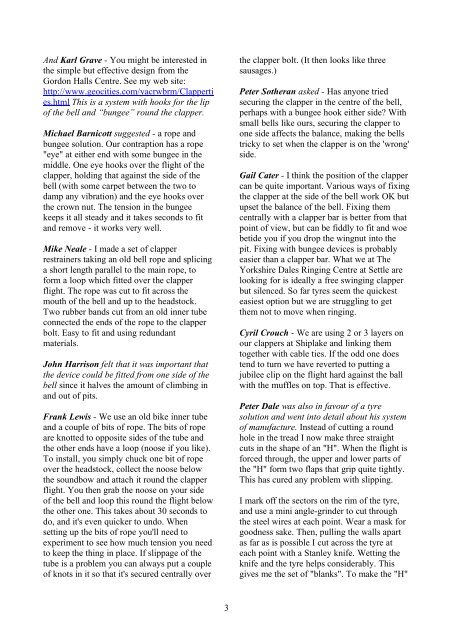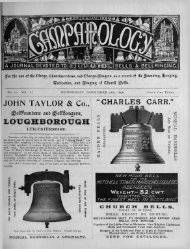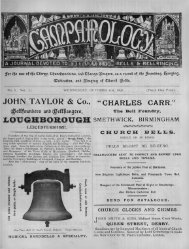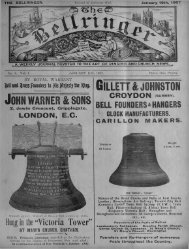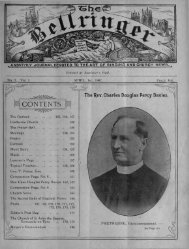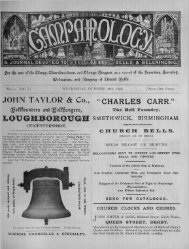The Central Council of Church Bell Ringers Education Committee
The Central Council of Church Bell Ringers Education Committee
The Central Council of Church Bell Ringers Education Committee
You also want an ePaper? Increase the reach of your titles
YUMPU automatically turns print PDFs into web optimized ePapers that Google loves.
And Karl Grave - You might be interested in<br />
the simple but effective design from the<br />
Gordon Halls Centre. See my web site:<br />
http://www.geocities.com/yacrwbrm/Clapperti<br />
es.html This is a system with hooks for the lip<br />
<strong>of</strong> the bell and “bungee” round the clapper.<br />
Michael Barnicott suggested - a rope and<br />
bungee solution. Our contraption has a rope<br />
"eye" at either end with some bungee in the<br />
middle. One eye hooks over the flight <strong>of</strong> the<br />
clapper, holding that against the side <strong>of</strong> the<br />
bell (with some carpet between the two to<br />
damp any vibration) and the eye hooks over<br />
the crown nut. <strong>The</strong> tension in the bungee<br />
keeps it all steady and it takes seconds to fit<br />
and remove - it works very well.<br />
Mike Neale - I made a set <strong>of</strong> clapper<br />
restrainers taking an old bell rope and splicing<br />
a short length parallel to the main rope, to<br />
form a loop which fitted over the clapper<br />
flight. <strong>The</strong> rope was cut to fit across the<br />
mouth <strong>of</strong> the bell and up to the headstock.<br />
Two rubber bands cut from an old inner tube<br />
connected the ends <strong>of</strong> the rope to the clapper<br />
bolt. Easy to fit and using redundant<br />
materials.<br />
John Harrison felt that it was important that<br />
the device could be fitted from one side <strong>of</strong> the<br />
bell since it halves the amount <strong>of</strong> climbing in<br />
and out <strong>of</strong> pits.<br />
Frank Lewis - We use an old bike inner tube<br />
and a couple <strong>of</strong> bits <strong>of</strong> rope. <strong>The</strong> bits <strong>of</strong> rope<br />
are knotted to opposite sides <strong>of</strong> the tube and<br />
the other ends have a loop (noose if you like).<br />
To install, you simply chuck one bit <strong>of</strong> rope<br />
over the headstock, collect the noose below<br />
the soundbow and attach it round the clapper<br />
flight. You then grab the noose on your side<br />
<strong>of</strong> the bell and loop this round the flight below<br />
the other one. This takes about 30 seconds to<br />
do, and it's even quicker to undo. When<br />
setting up the bits <strong>of</strong> rope you'll need to<br />
experiment to see how much tension you need<br />
to keep the thing in place. If slippage <strong>of</strong> the<br />
tube is a problem you can always put a couple<br />
<strong>of</strong> knots in it so that it's secured centrally over<br />
3<br />
the clapper bolt. (It then looks like three<br />
sausages.)<br />
Peter Sotheran asked - Has anyone tried<br />
securing the clapper in the centre <strong>of</strong> the bell,<br />
perhaps with a bungee hook either side? With<br />
small bells like ours, securing the clapper to<br />
one side affects the balance, making the bells<br />
tricky to set when the clapper is on the 'wrong'<br />
side.<br />
Gail Cater - I think the position <strong>of</strong> the clapper<br />
can be quite important. Various ways <strong>of</strong> fixing<br />
the clapper at the side <strong>of</strong> the bell work OK but<br />
upset the balance <strong>of</strong> the bell. Fixing them<br />
centrally with a clapper bar is better from that<br />
point <strong>of</strong> view, but can be fiddly to fit and woe<br />
betide you if you drop the wingnut into the<br />
pit. Fixing with bungee devices is probably<br />
easier than a clapper bar. What we at <strong>The</strong><br />
Yorkshire Dales Ringing Centre at Settle are<br />
looking for is ideally a free swinging clapper<br />
but silenced. So far tyres seem the quickest<br />
easiest option but we are struggling to get<br />
them not to move when ringing.<br />
Cyril Crouch - We are using 2 or 3 layers on<br />
our clappers at Shiplake and linking them<br />
together with cable ties. If the odd one does<br />
tend to turn we have reverted to putting a<br />
jubilee clip on the flight hard against the ball<br />
with the muffles on top. That is effective.<br />
Peter Dale was also in favour <strong>of</strong> a tyre<br />
solution and went into detail about his system<br />
<strong>of</strong> manufacture. Instead <strong>of</strong> cutting a round<br />
hole in the tread I now make three straight<br />
cuts in the shape <strong>of</strong> an "H". When the flight is<br />
forced through, the upper and lower parts <strong>of</strong><br />
the "H" form two flaps that grip quite tightly.<br />
This has cured any problem with slipping.<br />
I mark <strong>of</strong>f the sectors on the rim <strong>of</strong> the tyre,<br />
and use a mini angle-grinder to cut through<br />
the steel wires at each point. Wear a mask for<br />
goodness sake. <strong>The</strong>n, pulling the walls apart<br />
as far as is possible I cut across the tyre at<br />
each point with a Stanley knife. Wetting the<br />
knife and the tyre helps considerably. This<br />
gives me the set <strong>of</strong> "blanks". To make the "H"


